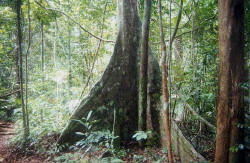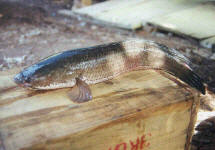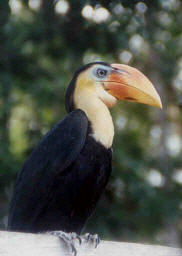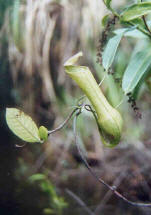Introduction
| |
|
|
 |
| |
Tasik Bera |
| |
|
Tasik Bera (Lake Bera) is located in the centre of
Peninsular Malaysia, in the southwestern corner of the state of Pahang.
There are many similarities to its more famous sister lake
Tasik Chini, which lies 50 km to the
northeast; both are shallow, seasonal, riverine lake systems which empty
into the Pahang River to the north. However, in contrast to the gross
mismanagement which affected the sustainability of Lake Chini's ecosystem,
Tasik Bera is an example of how a sensitive wetland area can be studied,
reviewed and developed for low-impact tourism with due regard given to its
indigenous tribes.
 |
|
|
Buttress roots of the
Keranji - used by the Semelai to make sheaths for their parangs
|
|
The shape of the lake system can be likened to a
forearm and hand pointing toward the southeast. Seven flooded river
valleys form the fingers of the hand, each extending over 10 km into the
surrounding peat swamps and lowland dipterocarp forests. In all the lake
area measures 35 km by 20 km and covers an area of 6150 hectares. Water
depth is shallow - between 2 and 5 metres only, thus it is categorised
as a "Wetland" i.e. it is less than 6 metres in depth. During the
monsoon season, from November to March, water levels may rise by 3
metres or more..
Oh, how we DANCED
In November 1994, Tasik Bera was declared Malaysia's
first Ramsar site, giving the area
some level of international recognition and protection. In addition, funds
from an environmental scheme known as DANCED, supported by the Government
of Denmark, were made available for a three year study of the area in
conjunction with the Pahang State Government and Wetlands
International-Asia. The main objectives of the three year scheme were to
establish a well-managed nature reserve at Tasik Bera, and to encourage
nature-based tourism with the participation of local indigenous
communities. The project's recommendations are now being implemented by
the state government.
An abundance of fish species
| |
 |
| |
The Haruan Channa striata
- this common species of snakehead fish often ends up in the local
market. |
| |
|
Tasik Bera's big attraction is the incredible
diversity of fish species. Almost 100 species of freshwater fish have
been identified, the majority being endemic to Peninsular Malaysia.
These include the highly valued, and thus endangered, Asian Arowana or
Golden Dragon Fish Scleropages formosus, the Silver Shark
Balantiocheilos melanopterus and the
Harlequin Rasbora
Rasbora heteromorpha. Other species include various Catfish,
Gouramy, Barbs and Carp. Mention must also be made of the Giant
Freshwater Puffer Tetraodon palembangensis which has the dubious
distinction of being a fish species which can be made into a Rebak or a
type of musical instrument !
Fishing is allowed in the lake - it is hoped that
the authorities will closely monitor fishing activities to prevent rarer
species from being overexploited, and that catch-and-release fishing
will become the norm.
 |
|
|
Juvenile Wrinkled Hornbill
Rhyticeros corrugatus |
|
| |
|
Curiously, bird life at Tasik Bera is not easy to
see, even though over 200 species have been identified in the area
including the Crested Fireback Lophura ignita the rare Malayan
Peacock Pheasant Polyplectron malacense, a stunning bird which
measures over 50 cm in length, with brown-patterned plumage, a shimmering
greenish or aquamarine crest and vivid orange facial skin with bold black
markings around its eyes. Other species identified on a recent trip
include various kingfishers (e.g. the common White-throated Kingfisher
Halcyon pileata), eagles (e.g. the rare Grey-headed Fish Eagle
Ichthyophaga ichthyaetus) and hornbills (e.g. the uncommon Wrinkled
Hornbill Rhyticeros corrugatus). Overnight visitors at the Persona
Lake Resort may well see a pair of Brown Wood Owl Strix leptogrammica
who frequently come to hunt in the area.
The forests around Tasik Bera also support a diverse
range of larger vertebrates including the Asian Tapir, Asian Elephant,
Clouded Leopard and rare Tigers, however visitors are unlikely to
encounter these animals; there are no viewing hides in place for the
visitor to remain concealed.
Exploring by Boat
| |
 |
| |
Small boats are required to
navigate the
hidden waterways of Tasik Bera |
| |
|
Thick stands of Pandanus helicopus dominate
the lake, dissecting it into narrow waterways and secluded bays. Exploring
this complex maze is best done by small boat; these can be easily hired
and most are owned by the local Semelai tribesmen who are expert in
navigation and boat handling.
It is worth anchoring in a secluded spot for an
hour, turning off the boat's outboard engine and sitting quietly to see
the wildlife slowly emerge. If lucky you may spot the Malayan False
Gharial Tomistoma schlegelii, a harmless but rare species of
freshwater crocodile, or even the endangered Striped Giant Softshell
Turtle.
 |
|
|
Pitcher plants, such as
Nepenthes gracilis, may be encountered along the narrow
waterways. |
|
| |
|
Secretive bird species, such as the shy but common
Pied Fantail Rhipidura javanica may also appear. Associated with
the Pandanus are fine examples of pitcher plants, such as
Nepenthes gracilis.
The Semelai
For over 600 years an aboriginal tribe or Orang Asli
have lived around Tasik Bera; these are the Semelai. Traditionally they
relied on fishing and hunting for food, but now many of the Semelai are
settled in villages where they have established vegetable plots and fruit
orchards. However, they still collect resin from species of Keruing (Dipterocarpus
sp.); this is done by cutting the bark of the tree and then lighting
controlled fires between the buttress roots, thereby keeping the resin
flowing freely from the wound. The resin or Minyak Keruing is used for
caulking of boats and for torches.
The Semelai harvest Pandanus leaves for
manufacture into handicrafts, and it is believed that this actually
controls the spread of the plants, thereby keeping the waterways
navigable. Areas of burned Pandanus show where the Semelai have
attempted to flush out terrapins or turtles for food. They are also adept
at trapping the Reticulated Python Python reticulatus in the nearby
oil palm plantations; the snakes are sold for their skins which probably
end up as leather goods. This has posed some threat to the species,
however given the experience elsewhere in the region where large
Reticulated Python survive in urban areas, it is unlikely this activity
would cause extinction of these snakes in Tasik Bera.
|